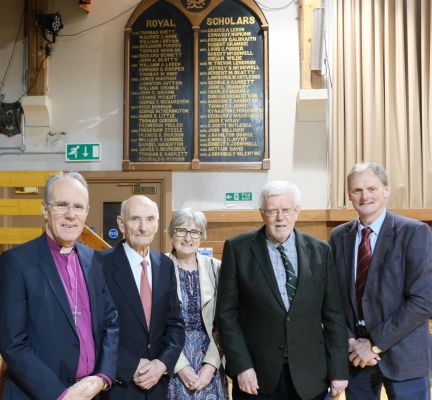 |
 |
News
The role of Royal School and its tenant farmers revealed in new book

At the launch of the new book on the Royal School and tenanted farmers.
A new book, “Enniskillen Royal School and its Tenant Farmers in the Nineteenth Century; Worlds Apart” detailing the origins of the School and the estate of land that was granted under the terms of the Plantation of Ulster in 1608 has been launched.
The book has been written by Mr Sam Morrow, a past pupil of Portora Royal School and a former member of the Board of Governors of Portora and its successor, Enniskillen Royal Grammar School for many years.
In the book, Sam traces the fortunes and challenges faced by the early Royal School and of the farmer tenants on the school estate during the 19th Century.
That estate of land was granted in 1608 to support at least one free school for County Fermanagh.

Bishop Ian Ellis launching the book.
The book was launched by Bishop Ian Ellis, Chairman of the Board of Governors of Enniskillen Royal Grammar School who referred to the long-forgotten story of the link between estate ownership, tenant farmers and the provision of a Royal School in Fermanagh.
“Sam takes us on a journey from Plantation times through the centuries to the Famine years and into the modern era. He explains how ultimately the assets of the estate were divided equally between the Fermanagh Protestant Board of Education and the Fermanagh Roman Catholic Board of Education,” Bishop Ellis told those attending the launch.
“This short history helps us understand how it has taken almost 400 years to deliver the original plantation aim of a Free school in Co, Fermanagh,” he added.
Sam Morrow outlined the events leading up to the creation of a Royal school which dates from
the early 17th Century, initially located in Lisnaskea, then at Schoolhouse Lane, Enniskillen, and from 1777 on Portora Hill.
The income from the estate, stretching from Lough Erne to Cuilcagh Mountain, supported the building and upkeep of the school until 1885 when the income from the estate and assets were divided equally between the Protestant and Roman Catholic Education Boards in County Fermanagh.
The estate was managed by the headmasters of the school until the 1820s when this responsibility was transferred to the Commissioners of Education.
Sam discovered how Enniskillen Royal School prospered during most of the nineteenth century but the same could not be said for the small tenant farmers on the school estate.
He writes; “Enniskillen Royal School was regarded as the most richly endowed of all the Royal Schools. Much has been written about the success of the school in the nineteenth century but much less about the source of its endowments.
“The school and its estate can trace their origins back to the Plantation of Ulster. The plan was that an estate of land would be set aside, the income from which would support at least one Free School for County Fermanagh. A school was established which, in time, developed with a particular emphasis on boarding. The school was described in a Commission of Education report in 1864 as being one of the most successful educational establishments in Ireland.
“Scholarships, funded from the rents paid by the tenant farmers on the estate, attracted pupils from all over Ireland.
The emphasis on boarding did not meet with the approval of the local community, who felt that the school was intended for the local population since it was funded by the tenantry on the school estate.
He added; “The Free Schools became Royal Schools by Royal Charter and Enniskillen Free School became known as Enniskillen Royal School from 1660 and, popularly, as Portora Royal School from the mid nineteenth century.”
Sam’s book traces the fortunes of the school and the struggles of the tenantry during some particularly difficult times in the nineteenth century.
The School estate once extended to some 5,570 acres from Lough Erne to Cuilcagh Mountain and most of this land was of poor agricultural quality, creating challenges for tenant farmers.
The book examines the causes and implications of many of the problems facing tenant farmers which became even worse during the years of the Great Famine in the 1840’s leading to arrears in rent payments and some evictions.
One of the farmers who now owns what was once tenanted land belonging to the school state is Mr David Brown, past President of the Ulster Farmers’ Union. His family had always assumed the land they now own, had once been owned by the Florence Court estate of Lord Enniskillen.
Speaking at the launch of the book, David said that in the 1800’s, the world’s population was 1bn and Ireland had a population of 8 million people but two-thirds of the Irish population were dependent on agriculture.
He said farmers in Ireland had always exported food to Great Britain and more so now as self sufficiency in GB is down between 50-60%. Northern Ireland farmers and food producers, for example, from a population of 1.9m produce enough food for 10m people.
He gave a detailed account of farming over the years and the importance of farmers today.
Also speaking was Richard Bennett, a former headmaster of Portora Royal School, commented on some of the facts unearthed in Sam’s book and Miss Elizabeth Armstrong, the current Principal of Enniskillen Royal Grammar School, spoke of Sam’s valuable knowledge of farming and education to put this book together.
The book is available from Enniskillen Royal Grammar School.